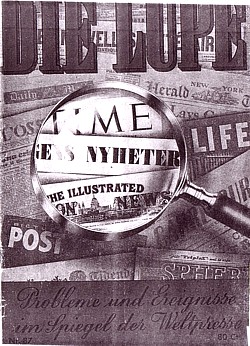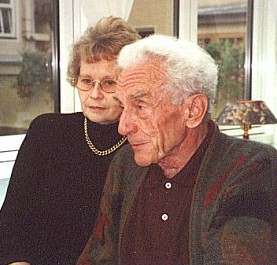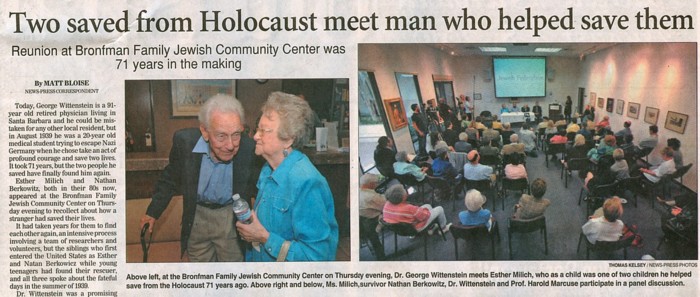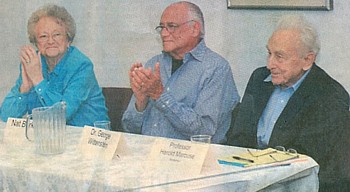|
Timeline
(back to top)
- 1918: Jürgen Wittenstein's parents were married. They are:
- Oskar Jürgen Wittenstein, a test pilot (the first person to fly an airplane in Bavaria). His book about Kantian philosophy, Von der Macht des Verstandes oder von der menschlichen Freiheit, was published posthumously in 1921. He was supposed to take over his father's dyeing company, and studied chemistry, philosophy and music in Munich, as well as taking flying lessons in France. He invented the halbstarres Luftschiff, a cross between a blimp and a zeppelin (dirigible). (Oscar Wittenstein German Wikipedia page)
- Elisabeth Vollmöller (born 1887), daughter of successful textile entrepreneur Robert Vollmöller (German wikipedia page). She took over the Hohen Beilstein castle (German wikipedia page; today's winery website; panoramic view) upon her father's death, learned winemaking, and carried on and expanded her father's business (Vereinigte Trikotfabriken [R.] Vollmöller AG), later founding the Vollmöller Mode fashion company in Berlin. Her four brothers and two of her four sisters were prominent and accomplished in their own right. Her brother Hans Robert Vollmöller (1889-10 March 1917) was a pilot--the first man to fly a plane in Württemberg (Wikipedia Hans Robert Vollmöller page). He introduced his sister to her future husband Oskar Wittenstein. Another brother was the playwright Karl Vollmöller (1878-1948)(Wikipedia Karl Vollmöller page; the German version is much more detailed), who (among other things) wrote the screenplay for the 1930 film The Blue Angel, starring Marlene Dietrich. On Mathilde Vollmöller see this German wikipedia page; on Martha see p. 5 of this University of Tübingen pdf.
- More information about their families is contained in these notes about a Jan. 2001 interview.
- 1918: Jürgen Wittenstein's father died in a plane crash shortly before World War I ended in November, namely on September 3, 1918. He had only been married for four months.
- 1919, April: Jürgen
Wittenstein was born in Tübingen University hospital, which was not far from Beilstein, which is about 40 miles north of Stuttgart
- ca. 1931-1937: Wittenstein attended the boarding school at Salem near Lake Constance (Bodensee), at first under the headmaster Kurt Hahn (1886-1974), a progressive Jewish educator who was arrested and held March 11-16, 1933 for speaking out against Hitler in the school. In July 1933 Hahn emigrated to Scotland, where he founded Gordonstoun school based on his Salem principles. In 1941 he founded Outward Bound, and in the 1950s he founded the United World Colleges. (wikipedia Hahn page; Outward Bound publication and bio). Hahn's principles and principled stance were a strong influence on Wittenstein.
- 1937: Wittenstein graduated from high school (Gymnasium), completed 6 months of compulsory Reich Work Service, then two years of compulsory military service.
- 1938:
- Wittenstein met Alex Schmorell during their training in a hospital company (medical students were required to do this during the last 6 months of their compulsory military training)
- Wittenstein met the Munich book seller Josef Söhngen, to whom he later introduced Hans Scholl. (In a third White Rose trial Söhngen was given a prison sentence for hiding leaflets in his cellar.)
- 1939:
- April. Wittenstein received a trip to the US as a birthday present from his mother. The trip was delayed until late in the summer, when his mother had to take a business trip to England, as she commonly did.
- Aug. 23-25: Wittenstein's attempted passage from Hamburg to New York on the Hansa failed when the ship turned around before docking at Southhampton, England, where his mother was waiting to join him. He was taking a car for use on his "vacation" with him, a common practice at the time. However, he did not plan to return to Germany, and chose the most expensive GM car built in Germany because it would have a higher resale value in the US than German makes, since spare parts were readily available.
- Aug. 26: Wittenstein used that car to drive Esther and Natan Berkowitz to Berlin, where he stayed for several days instead of heading to Belgium to attempt his passage/emigration to the US by another route.
- Early Sept: By this time the war has broken out, making the passage impossible. His mother has flown to Zurich, and both returned home to Beilstein. In order to be allowed to study at Munich university, all students were required to absolve harvest service
- October/November: Wittenstein began the study of medicine in Munich, where he became friends with Hellmut Hartert and Hartert's best friend Hans Scholl. They often went hiking from Hartert's home town of Bad Tölz south of Munich. Wittenstein introduced Schmorell to them; Schmorell brought along his friend Christoph Probst. Wittenstein has a 2-seater Ford Eifel Roadster car.
- 1940: Wittenstein was posted to Prague for his summer military service
- 1941: In June the popular professor Fritz Joachim von Rintelen "disappeared." Wittenstein and Remigius Nezter demand his whereabouts from the university president, then organize a public protest march of 50-80 students to the president's apartment.
- 1942
- Hubert Furtwängler and later Wolfgang Jaeger joined the group of medical student friends
- June: resistance activities under the name "White Rose" begun by Alexander Schmorell and Hans Scholl, who wrote, duplicated and distributed 4 leaflets in a 16-day period
- June 27: Leaflet 1 distributed (about 100 copies; 35 were turned in to the Gestapo)
- Wittenstein looked over the third and fourth leaflets
- July 12: Leaflet 4 distributed
- July: Willi Graf (who met the 5 original medical student friends on the way to the Russian front), Christoph Probst (who was in the air force and at the University of Innsbruck), and Hans's younger sister Sophie Scholl learn about the leafleting activities
- July 23: Graf, Scholl and Schmorell served as medics on the eastern front
- Sept.: long train ride through the Soviet Union, during which Alex develops diphtheria
- Nov. 6: they arrived back in Munich
- Dec: Professor Kurt Huber told about the group's activities
- Traute Lafrenz made contacts with a student group in Hamburg
- Wittenstein has contacts in Berlin, whence he wanted bring leaflets
- 1943
- Jan. 13: Munich students disrupted a speech by Nazi Gauleiter at a lecture hall in the German Museum
- Jan. 25-28-Feb: leaflet 5 distributed
- Feb. 4, 8, 15: anti-Nazi slogans painted on 29, 2 and 4 public places in Munich [Moll 1994, 187f]; heightened activity after German 6th army surrendered at Stalingrad Feb. 4
- Wittenstein painted slogans in the university's toilets with India ink
- Feb. 18: Hans and Sophie arrested while distributing a 6th anti-Nazi leaflet
- Based on the handwriting of a draft leaflet found in Hans' pocket, Christoph Probst is identified and arrested soon afterwards in Innsbruck.
- Alex Schmorell, on his way to the university in a streetcar, learned that there is a lockdown there and fled.
- Feb. 19: Wittenstein, who received the order that all medical students are to report to their barracks, learned that two students were arrested for resistance activities. He figures that they are Hans and Sophie Scholl. He convinces his commander that Schmorell didn't receive the order to report to the barracks and is allowed out to fetch him. He visits Alex's father in his office and leaves a message for Alex that he should use the prearranged escape route to Switzerland. (Instead, Alex tried to escape via a different route and had to turn back because of deep snow. He was turned in by someone in Munich who recognized him trying to enter an air-raid shelter.)
- Feb. 21: Wittenstein, who had coincidentally learned that Hans and Sophie were on trial, called their parents and told them that their children have been arrested and are on trial for high treason.
- Feb. 22, Monday:
- The Scholl siblings and Christoph Probst are tried in the "People's Court" (Volksgerichtshof), which was brought from Berlin to conduct this trial. This takes place in the Munich Palace of Justice
- The trial is over around noon. At 4pm the convicted students are informed that they will not receive clemency. By 5pm Hans (24), Sophie (22), and Christoph Probst (24) are beheaded by guillotine.
- Wittenstein himself is never put on trial because he was protected by his army commander (he learned this after the war). He was, however, interrogated by the Gestapo in November. Later he was brought before a court martial, accused of helping the Jewish mother of Hans Leipelt. To escape the jurisdiction of the Gestapo, he volunteered for service on the Italian front [Axelrod 2001, 25, 97; Wittenstein in Michalczek 2004, 207]
- Feb. 24: Alex Schmorell returns to Munich and is arrested
- Feb. 26: Prof. Kurt Huber is arrested
- April 19: Second White Rose trial. 3 more death sentences (Alexander Schmorell, Willi Graf, Kurt Huber) and 9 prison terms for other White Rose members:
- Hans Hirzel, Susanne Hirzel, Franz Joseph Müller, Heinrich Guter, Eugen Grimminger, Heinrich Bollinger, Helmut Bauer, Falk Harnack, Gisela Schertling, Katharina Schüddekopf, Traute Lafrenz.
- July 13: Alexander Schmorell (age 25) and Kurt Huber (age 49) are executed
- A third White Rose trial takes place, against Wilhelm Geyer, Harald Dohrn, Josef Soehngen, and Manfred Eickemeyer. Gisela Schertling recanted her incriminating testimony, and only Soehngen received a sentence (6 months).
- Oct. 12: Willi Graf (age 25) is executed
- 1944
- Oct. 13: Hans Leipelt, a "half-Jewish" chemistry student, is tried and sentenced to death. He was turned in for distributing copies of the 6th leaflet after the first trial, and collecting money to support the widow of Prof. Kurt Huber. He was executed on Jan. 29, 1945.
- 1945
 Jürgen Wittenstein is wounded in Italy. He collects weapons from wounded soldiers and smuggles them to the Freedom Action Bavaria resistance group. Jürgen Wittenstein is wounded in Italy. He collects weapons from wounded soldiers and smuggles them to the Freedom Action Bavaria resistance group. - April 27: Freedom Action Bavaria uprising in Munich, the only successful military putsch against the Nazi regime
- 1946: Jürgen married his first wife, Elisabeth Sophie Hartert, on his birthday (April 26th) in Heidelberg.
- 1947: Wittenstein emigrates from Germany, via England. His wife was unable to obtain a visa until two years later.
- He publishes an article about the White Rose, titled "Die Münchener Studentenbewegung" (The Munich Student Movement), in the newspaper Blick in die Welt (Hamburg). It is reprinted in the August 1948 issue of a digest of articles from other occupation zones in the US zone's monthly journal Die Lupe, pp. 33-41 (5 page pdf). For forty years, Wittenstein does not publish or speak about the White Rose--there is little public interest. He finally begins to speak again when the families of his other friends bring to his attention that there is an almost exclusive focus on the Scholl siblings.
- 1948: Wittenstein immigrates to the US, where he attends Harvard medical school
- 1953: Wittenstein co-writes an article, "Nebenniereninsuffizienz: Diagnose und Behandlung," which he translates into German for publication in a Swiss medical journal [hm: I searched the WorldCat database for GJW's publications, which yielded this one and his 1956 thesis]
- In Denver, Colorado Wittenstein and his wife Elisabeth, now an anesthesiologist, have four children: Eva Deirdre, Nemone Elisabeth, William Andreas and Catharina Joyce
- 1956: Wittenstein completes his thesis for his M.Sc. in surgery at the University of Colorado, Denver: The Dermatome Test: An Aid in the Diagnosis of the Acute Abdomen.
- 1956: Wittenstein receives an academic appointment at the University of Colorado Medical Center
- 1960: Dr. Wittenstein takes a position at the UCLA medical center. The Wittensteins purchase a property in Santa Barbara, where he helps to build the house in which he lived until the last years of his life. (He had enjoyed and practiced carpentry during his school years in Salem, Germany.)
- 1964: Wittenstein corresponds with Hellmuth Auerbach of the Munich Institut für Zeitgeschichte about a transfer of documents.
- 1966:
Dr. Wittenstein's first wife Elisabeth dies of cancer on January 15.
- Dr. Wittenstein marries Dr. Christel Bejenke, an anesthesiologist at UCLA medical center.
- 1992: Wittenstein gives a short presentation at a White Rose symposion at the University of California, Santa Barbara. In 1994 it is published as "The White Rose: Questions and Reflections," in Soundings, a journal published by the UC Santa Barbara library. (pdf)
- 1993: Wittenstein presents a lecture "The White Rose" at a World War II conference at Siena College near Albany, New York in June.
- 1994: Nat Berkowitz records interview with the Shoah Visual History Foundation, in which he mentions the man who helped him and his sister get from Hamburg to Berlin in August 1939
- 1997: Dr. Wittenstein delivers lecture to the LA Jewish Federation, later published online as "Memories of the White Rose." (in 4 parts at historyplace.com)
- 2000, March: interview with Andrea Übelhack, Eva Ehrlich and David Gall of
haGalil online, published in July 2001 as "A Conversation with Jürgen Wittenstein: 'Someone Had to Do It'"
- 2001:
- Dr. Christel Bejenke, Wittenstein's second wife, begins research to find the teenagers George helped in 1939. She obtained the schedule of the Hansa in 1939, and then the passenger list for the August 1939 trip from Hamburg to New York.
- 2002: Oral history of Dr. Wittenstein begun by UCSB oral historian David Russell (UCSB library page)
- 2004: Wittenstein publishes an essay, "The White Rose: A Commitment," in:
Confront! Resistance in Nazi Germany, edited by John J. Michalczyk (New York : P. Lang, 2004), 191-210. UCSB:
DD256.3.C65 2004 (google books) (pdf)
- 2007: Wittenstein Lecture Series inaugurated at UCSB (press release; homepage; SB Independent article)
- 2009
- Feb: interview with channel 17 hosts Lorrie and Bill Hull Smithers (Part I: 28 min. flash video; part II: 30 mins.)
- April: Dr. Wittenstein delivers Oregon State University Holocaust Memorial Lecture, "A Personal Account of the White Rose" (link updated 12/31/13)
- May: Dr. Wittenstein speaks at the UCSB Interdisciplinary Humanities Center, "Who Determines What Becomes History?
A Witness's Reflections." (DVD available for puchase for $20 from UCTV [$26.05 with tax & shipping])
- September: Dr. Wittenstein reviews his 1939-42 photo albums with UCSB Prof. emerita Ursula Mahlendorf. Their dialog is recorded on 8 hour-long digital videotapes.
- 2010
- April 26: on Dr. Wittenstein's 91st birthday he finds out that the 2 teenagers he helped in 1939 are living in New York.
- August 3-5: reunion of Dr. Wittenstein and Esther and Nat Berkowitz, the Jewish teenagers whom he helped return to their parents in Berlin in August 1939
(article in Santa Barbara News-Press, as scan; page with photos of Aug. 5 panel discussion)
- 2011: A three-volume oral history of Dr. Wittenstein by UCSB oral historian David Russell is completed.
- 2015, June 14: Dr. Wittenstein died in Santa Barbara, California, at age 96. A detailed obituary was published in the local Santa Barbara Independent.
|



